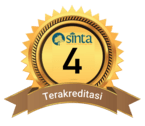Pembelajaran Integratif: Menyimak Puisi dan Menulis Cerita Pendek
Abstract
Language skills are commonly integrated in Indonesian language learning. In this integration, student activities involving listening and reading skills will lead to speaking and writing activities. However, in the learning process, the integration is always related to the same type of text. In fact, teachers can combine different types in learning Indonesian. Therefore, the aim of this article is to explain the integration of listening poetry and writing short stories. The integration will be explained in the discussion section in which the relationship between listening poetry and writing short stories and the implementation in Indonesian language learning are discussed. This article is expected to be used as a reference in Indonesian language learning so that there is an involvement of various texts in writing short stories.
Full Text:
PDFReferences
Cazden, C. (1988). Classroom Discourse: The language of Teaching and Learning. Portsmouth, NH: Heinemann.
Chall, J. (2000). The Academic Achievement Challenge: What Really Works in the Classroom? New York, NY: Guilford Press.
Collins B. C. (2001). Teaching the Language Arts: Expanding Thinking through Student-Centred Instruction (2nd ed.). Boston, MA: Allyn & Bacon.
Dewi, N. P. E. F., Martha I. N., dan Wendra, I. W. (2016). Kesulitan Belajar Keterampilan Menulis Cerita Pendek Siswa Kelas Ixc SMP Negeri 3 Singaraja Tahun Pelajaran 2016/2017. Jurnal Pendidikan Bahasa dan Sastra Indonesia Undiksha, 5(3): 1-12.
Dunn, M. & Finley, S. 2010. Children’s Struggles with the Writing Process: Exploring Storytelling, Visual Arts, and Keyboarding to Promote Narrative Story Writing. Multicultucal Education.
Harmer, J. 2007. The Practice Of English Language Teaching The Practice Of English Language Teaching (4th Ed.). USA: Pearson Education Limited.
Hughes, J. 2007. Poetry: A Powerful Medium for Literacy and Technology Development. Diakses di http://www.edu.gov.on.ca/eng/literacynumeracy/inspire/research/hughes.pdf
Oatley, K. 2002. Emotions and the Story Worlds of Fiction. In M.C. Green, J.J. Strange, & T.C. Brock (Eds.) Narrative impact: Social and Cognitive Foundations, pp. 39-69.
Pratiwi, N. Y. 2019. The Analysis of Problems Encountered by Beginner Writer In Writing A Short Story: A Case Study in Creative Writing Class. Indonesian Journal of Educational Research and Review, 2(3): 402-407.
Putra, D. P. 2013. Kemampuan Menulis Cerpen Siswa Kelas X 1 SMA Negeri 1 Melaya Ditinjau dari Unsur Intrinsik. Jurnal Pendidikan Bahasa dan Sastra Indonesia Undhiksa, 1(8):1-12.
Semi, M. A. 2008. Stilistika Sastra. Padang: UNP Press.
Syafrina, D. 2017. Pengembangan Model Lintaskujitu dalam Pembelajaran Menyimak Fabel untuk Siswa Kelas VII SMP. Tesis. Malang: Universitas Negeri Malang.
Syafrina, D., Dermawan, T., dan Widiati, N. 2017. Implementasi Pembelajaran Menyimak di Sekolah Menengah Pertama. Jurnal Pendidikan: Teori, Penelitian, dan Pengembangan, 2(5): 706-713.
Umar, S. 2016. Peningkatan Keterampilan Menulis Cerpen dengan Strategi Copy The Master Melalui Media Audiovisual pada Siswa Kelas IX A SMP Negeri 2 Tolitoli. Jurnal Kreatif Tadulako Online, 4(6): 282-300
Wassiliwizky, E., Koelsch, S., Wagner, V., Jacobsen, T., & Menninghaus, W. (2017). The Emotional Power of Poetry: Neural Circuitry, Psychophysiology and compositional Principles. Social Cognitive and Affective Neuroscience, 12(8):1229–1240.
Watts-Taffe, S., & Truscott, D. (2000). Using What We Know about Language and Literacy Development for ESL Students in the Mainstream Classroom. Language Arts, 77(3): 258-264.
DOI: https://doi.org/10.24036/ls.v2i2.32
Refbacks
- There are currently no refbacks.
![]()
This work is licensed under a Creative Commons Attribution-NonCommercial 4.0 International License.
Published by:



